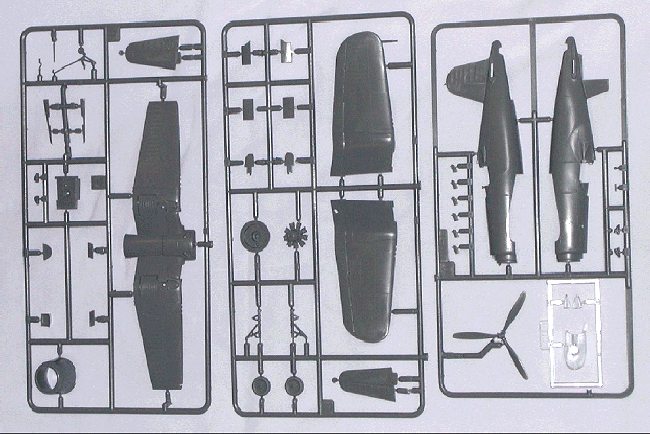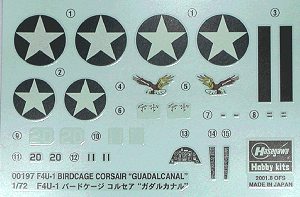
|
KIT: |
Hasegawa 1/72 F4U-1 Corsair |
|
KIT # |
00197 |
|
PRICE: |
$13.95 |
|
DECALS: |
Two Aircraft |
|
REVIEWER: |
|
|
NOTES: |
'Guadalcanal' boxing |

|
HISTORY |
History: The F4U Corsair was ordered in 1938 and became one of the most famous
fighter aircraft ever produced. It holds the distinction of having the longest
production run of any World War II US fighter, the last example not being
delivered until late December 1952.
The The F4U-1 was the first model to be delivered to the Navy. The aircraft
featured a heavily framed canopy that restricted the pilot’s vision and had
handling characteristics they deemed unsuitable for a carrier based aircraft.
In spite of this, it was clear to the Navy that they had a capable gun platform
so the aircraft was farmed out to land based units until improvements in the
canopy and handling made is acceptable for carrier use. (Of course, the fact
that the British were very happy operating clipped-wing Corsairs from carriers
might have helped speed up this process a little....)
This original F4U-1 variant was known as the “birdcage” Corsair because of this
heavily framed canopy. The cockpit location resulted in poor visibility not
only in the landing phase, but also when the aircraft was being taxied on the
ground.
The canopy was modified part-way through the production run by creating a “bump”
in the plexiglas over the pilot’s head, allowing for better visibility during
taxi and landing operations. Because later Corsair variants built with “blown”
canopies officially shared the the same F4U-1 designation, it’s hard to
determine exactly how many birdcage variants were produced.
This variant was the first of the series to see battle, beginning operations at
Bougainville in February 1943 with VMF-124. VF-17 followed suit in March in New
Georgia.
|
THE KIT |

I’m not sure when Hasegawa first issued this kit, but I’m
sure it was quite some time ago as all of the panel lines are raised. (Readers
who would like to see what the Hasegawa F4U-1 looks built up should
see this review. Ed) The
detailing is very well done, so I wouldn’t list these as a negative. There is
some flash on the engine and ejector pin marks on both the main wheels and gear
doors, but nothing too dramatic.
The kit contains 36 gray parts on three sprues along with several other parts
for a later variant that can go directly to your spares box. As is typical of
Hasegawa, the cockpit interior is represented by decals and should be adequate
for the scale. The canopy framing will hide some, and what it doesn’t hide will
be very hard to make out as the canopy is fairly thick and the “bump” is
distorted. Otherwise the clear parts are fine. Hasegawa doesn’t provide
the flat top birdcage canopy.
True Details makes a nice cockpit set for this kit and you can get a crystal
clear vacuform replacement canopy from Squadron to show it off. I’ve never
installed a vacuform canopy before, but I think this kit may be my first as the
vacuform
sliding section is much nicer than the stock piece. The kit’s rear cockpit
windows will still have to be used with this set.
The kit instructions are easy to follow and only consist of five construction
steps. The painting guide specifies Gunze paints, of course, but there are
FS numbers for the main camouflage colors. I’d recommend checking any one of a
number of good books on the Corsair to verify detail colors and markings.
 The decals are present options for two Guadalcanal-based aircraft belonging to
VMF-213. Both are covered in Osprey’s Corsair Aces book listed below.
The decals are present options for two Guadalcanal-based aircraft belonging to
VMF-213. Both are covered in Osprey’s Corsair Aces book listed below.
The first option is for 1st Lt. Foy Garison. Lt. Garison shot
down two Zeros in June 1943, but was himself shot down and killed just 17 days
later. The second aircraft is for 1st Lt. George Defabio, who claimed three
Zeros in July 1943. The
Osprey book tells their stories and has color plates for both aircraft. (The
photos show Defabio’s No. 11 with the bumped canopy, while the color plates for
both aircraft show them with the flat canopy. Modeler beware!) The kit decals
are
thick but usable (in short, typical Hasegawa), but aftermarket decal sheets are
available, too.
|
CONCLUSIONS |
Even with raised panel lines, this kit should build up very nicely. Recommended to all. Modeling Madness readers will find a nice review of the Hase 1/72 F4U-1 at this link.
Review kit courtesy of me and my wallet!
|
REFERENCES |
Mark Styling, Corsair Aces of World War 2, Osprey Aerospace, 1995
Jim Sullivan, F4U Corsair in Action (Aircraft Number 145), Squadron/Signal
Publications, 1994
Gordon Swanborough and Peter Bowers, United States Navy Aircraft since 1911,
Naval Institute Press, 1990
If you would like your product reviewed fairly and quickly by a site that has well over 150,000 visitors a month, please contact me or see other details in the Note to Contributors.